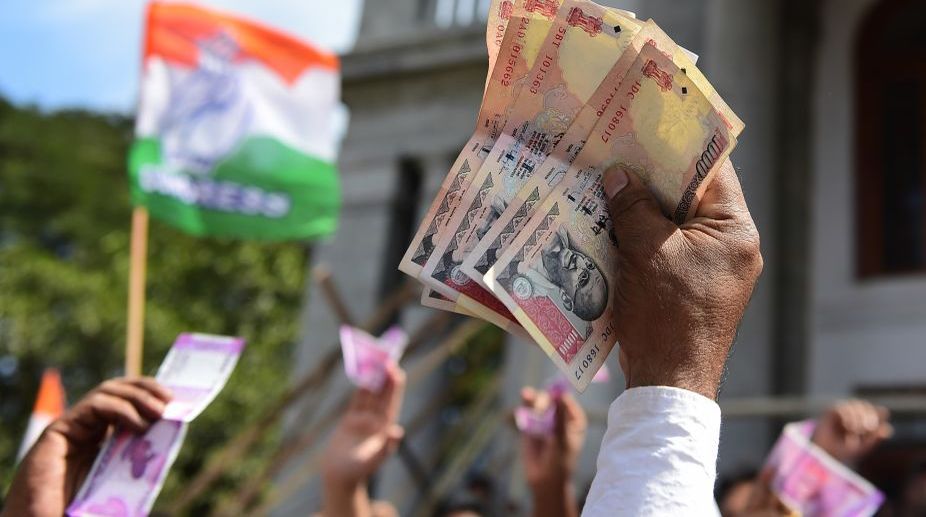Many large companies to move Appellate Authority against GST demand notices
In recent days, an increasing number of GST notices have been sent to many companies mainly on account of alleged discrepancy in input tax credit (ITC).

(Photo: AFP)
The opposition is planning to hold countrywide protests against last year’s demonetisation and the introduction of Goods and Services Tax, on November 8, calling it a “Black Day”. On this day last year, Prime Minister Narendra Modi had thrown a bombshell when he announced that Rs 500 and Rs 1,000 notes were no longer legal tender.
Since then demonetisation has been the most hotly debated topic as it was said to have thrown the economy out of gear. Added to that was the July introduction of Goods and Services Tax which created confusion and discontent among the public. This was intended to rationalise taxation, which the government claims will be beneficial in the long run. Starved of issues to hit the Modi government, an amalgamation of 18 opposition parties including the Congress, Mamata Banerjee’s Trinamool Congress and the Left have declared that they will observe next Wednesday as a ‘black day’ with protests and rallies in different parts of the country.
The catchline for the protests will be “Bhugat Raha Hai Desh” (the country is suffering). Also beginning November 8, for three days central trade unions plan to demonstrate against the Modi government’s economic policies and its impact on both organised and unorganised sector workers. However, given that many regional rivals among these 18 parties, such as Trinamool Congress and Left in Bengal, Congress and Left in Kerala and SP and BSP in UP, have difficulties in lining up their respective supporters under one banner, each of these parties will stage their own protests.
Advertisement
While the opposition cannot fault the government for its fight against black money, it can only criticise the way demonetisation was resorted to without preparation. Congress leader Rahul Gandhi has said while the economy was able to withstand the “torpedo” of note ban, it could not withstand the GST one. Rahul Gandhi called the GST “Gabbar Singh Tax” referring to the notorious villain of the movie ‘Sholay’ hoping that this might click in poll-bound Gujarat and Himachal Pradesh.
Modi has already made a strong pitch around demonetisation in his campaign rallies claiming the opposition’s frustration was after losing huge chunks of black money. Senior politicians like P Chidambaram and West Bengal chief minister Mamata Banerjee have called demonetisation a big scam, which facilitated the conversion of black money. While the jury is still out on the impact, there is no doubt that demonetisation caused inconvenience to the public.
With the slowdown in sectors like real estate and finance, it seemed an inescapable conclusion that this decline in economic momentum was linked to demonetisation. Small traders and businessmen are affected by the introduction of the GST most while the consumers also feel the heat. Secondly, it has hit the informal sector, which employs about 90 per cent of the work force including daily wage earners, street vendors and others. There were also massive job losses, less spending by consumers and other related adverse impacts. Thirdly it hit credit growth.
Fourthly, World Bank had brought down the 2016 GDP to 7 per cent from the projected 7.2 per cent.The IMF had also brought it down to 6.7 per cent while the ADB had reduced the projection to 7 per cent. Fifthly, for demonetisation of currency notes, the RBI had to incur massive expenditure for printing of new notes.
To counter the opposition politically, the government is also planning to celebrate one year of demonetisation as ‘Anti Black Money day’ on November 8 claiming that both GST and demonetisation are key structural reforms that will deliver massive benefits to the economy in the long run. Senior party leaders and NDA ministers will fan out and propagate the success of the reform measures. Much of the focus is on the economic consequences even though politics cannot be ignored. Modi has tried to project it as a dramatic measure to enhance his regime’s fight against corruption. As a political decision it paid dividend particularly in UP, and projected Modi as a pro- poor leader. While the opposition is trying to take up the two economic issues for its political purposes, the government is on the defensive.
Finance Minister Arun Jaitley argues that the impact of demonetisation cannot be determined solely by looking at windfall profits. He dismisses the Opposition’s allegation that the note ban was a scam. The government is touting the benefits pointing out that almost ninety per cent of the demonetised notes have come back to the banking system. Secondly, people now realise that holding excessive cash at home is not good. It has instilled fear among tax evaders. Thirdly, Jaitley claims that the Income tax department showed a growth of about 41.79 per cent in the collection of Advance Tax under Personal Income Tax. Fourthly, after the demonetisation, over 37,000 shell firms were detected and registrations of more than one lakh shell companies had been cancelled. Fifthly, Chief Economic Adviser Arvind Subramanian claims that there has been a 20 per cent reduction in cash in the economy after the measure.
In the past year, Opposition parties have staged protests in different parts of the country but it did not result in a larger expression of dissatisfaction. It is not clear how effectively this divided strategy will work on the ground and also as an election issue. Will they be able to mobilise enough public support? How far will the confrontation go? Is there enough public anger for them to come out to the street? These are the questions next week might answer.
Advertisement